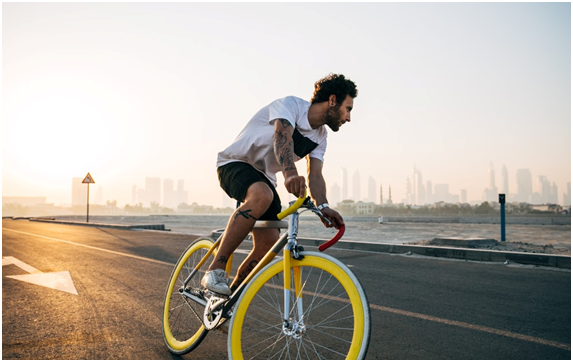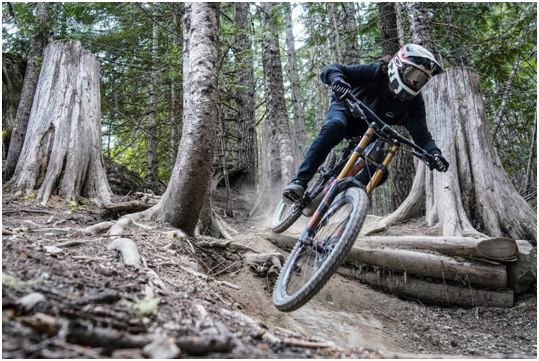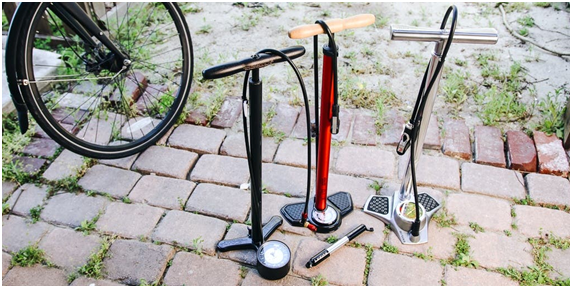
The right pounds per square inch (PSI) in your bike tires makes a whole world of difference. Yet, many newcomers to cycling fail to inflate their bike tires with the proper pressure. Ideally, some don’t even know much about bike tires except that they’re either flat or not and good or bad to ride.
It would be an overstretch to say less air equals more comfort in riding and more air equals faster speed. While the statement may have some element of truth to it, the right tire inflation for maximum performance depends on the bike and the rider’s needs.
We break down some important information you need to know and have, which may help you understand the right PSI for bike tires. It’s our understanding that, just like automobiles, bicycle tire inflation can have some considerable effects, especially on handling traits and efficiency.
You, as a cyclist, can, therefore, use some of these effects to your advantage. Without dwelling much on what they are, let’s jump right in and learn one or more things about tire inflation.
The Basics of Bike Tire Inflation
Before adding any pressure to your bike’s tires, you need to know some basic facts about the tire and the bike. You can check the tire pressure through a pump with a pressure gauge. A better alternative could be a digital pressure gauge or a separate analog one.
When you’re dealing with a bicycle, you need to know the two commonly used pressure measurement units to avoid mistakes. Pounds per square inch (psi) and bar are the units, where most tire manufacturers give precedence to PSI over the bar.
Both PSI and bar come with the recommended tire pressure, ranges to consider, and maximum pressure you can inject into any tire. The information is always indicated on the tire’s sidewalls or rims for ease of access. You must follow those strict recommendations to stay safe and avoid problems when riding the bike or adding pressure.
In rare but possible instances where the pressure information is missing, there are lists with recommended tire pressure you can refer to. Take note of your bike type and the cyclist’s weight since they are vital to the pressure needed.
Let’s also point out with caution that these are approximate figures, so one must pay close attention to optimal pressure that depends on several factors. Some of those factors are looked at below for your consideration.
Elements of Optimal Tire Pressure
As briefly touched on the basics of tire inflation, there are vital factors that affect bike tire pressure that you need to bear in mind before doing anything to your ride or its tires. The ones looked at here stand out and need to be given weight at all times.
If you find others relevant to your tire pressure needs, feel free to incorporate them as you see fit to keep your tires in good shape for the next ride.
Tire Width
A wide tire needs less pressure, so if you choose a bike with tires of 25 to 28 mm, you need fewer PSI to balance on it properly. Ideally, the pressure should hover around 10% less than the recommended pressure.
Cyclist’s Weight and Luggage
Generally, more weight equals more pressure. It doesn’t matter the rigors of your bike’s use; heavy riders must use high PSI to get similar tire performance as lighter cyclists. Since there are no rules as to what you must have, play around with the pressure until you get what you feel best suits you.
The weight of what you carry with you during your riding sessions must be considered when adding pressure to your bike’s tires. Don’t forget to adjust the rare tires accordingly since they tend to carry more weight than the front tires.
Weather and Temperature
Through physics, you must be aware that temperature has a direct effect on air pressure. Wet conditions call for lower tire pressure to avoid being unstable and losing grip while cycling. The muddy conditions call for a high, fat, and spaced lug tire tread pattern and not just lowering the pressure.
In extreme temperature differences, especially indoors and outdoors, you need to adjust your tire’s pressure appropriately. The warmer the temperature, the higher the bike tire PSI, and the colder it is, the lower the tire pressure.
Tubeless System
Unlike bike tires with tubes, tubeless ones give you the flexibility of running at lower air pressure for increased grip and comfort. The usual friction between tire and tube also becomes a thing of the past as the same tire pressure PSI makes the bike faster.
Overinflation vs. Underinflation
In simple terms, don’t be a victim of these two. You run the risk of blowing your tube if you overinflate, especially when pumping or riding due to constant or sudden impact. Underinflation may cause pinch flats due to the low pressure.
Your bike’s tire tube can easily get squeezed between the tire casing and the rim, mostly when you hit a bump with that underinflated wheel. There’s also the risk of hurting the rim, apart from damaging the tire. It’s not fun to ride such a bike since you have to pedal harder to move.
Tire Casing
Tires made of high TPI are generally lighter in weight and are more flexible and faster. Such tires require more pressure to perform better and also become puncture-less. Conversely, low-TPI tires are stiff, heavy, and slow, although they last longer and are better puncture-resistant. They permit PSI reduction to gain traction or damping without giving rise to a risk of punctures.
Usage Frequency
If you’re a frequent user of the bike, you need to keep it inflated as often as possible. Apart from the frequency of usage, analyze how hard you ride the bike as well. Some people regularly break the pumps, so regular check-ups are a must.
Terrain Conditions
It goes without saying that bumpy roads need low-pressure tires, while smooth surfaces call for high-pressure tires. Again, remember that you’ll not often find perfectly smooth roads because they’re not that common.
Types of Bikes and Their Recommended PSI

As we’ve seen before, every bike tire has its recommended PSI printed on its sidewall or rim. The figure is typically a range to serve as a guide on the lowest and highest pressure ends. The table below presents some of the recommended pressure ranges for your tires.
Type of the Bike Tire | Ranges of PSI |
Tires for kids’ bikes | PSI 20–40 |
Narrow tires for road bikes | PSI 80–130 |
Medium tires for hybrid bikes | PSI 50-70 |
Thick tires for mountain bikes | PSI 30 (off-road)PSI 50 (on-road) |
1.Road Bikes

These are bikes built for speed on smooth terrain, so higher air pressure makes them roll with ease and speed. Referring to the table above, you can see the ideal PSI ranges. However, some racers stretch the number as high as 160 PSI.
2.Mountain Bikes

These bikes are the complete opposite of road bikes and basically fly over loose and bumpy surfaces. To avoid too much bounce and a jolty ride, you don’t need tires with too much air. Instead, lower your tire pressure.
The low tire pressure helps with shock absorption while increasing traction due to the fact that the tire touches base with the ground. The recommended PSI is between 30 and 50 for most bikes since it gives a nice balance on-road and off-road.
3.Cyclocross Bikes
Cyclocross tires are meant for high pressure compared to mountain bike tires. These gravel bike tires require lower pressure than the ones for narrow road bikes. They are excellent tires for a compromise between rolling resistance and grip.
The ideal PSI for an inner tube tire for this bike is 48 PSI for the front tire and 50 PSI for the rear tire. A tubeless tire requires 36 PSI in the front and 38 PSI in the rear. These measurements are for a rider weighing 70 kg but are adjustable as appropriate.
4.Turbo Trainers
When it comes to bike tire pressure, it’s not only about your usual bike tire. If you own a turbo trainer, you may need to reduce the pressure in your turbo tires for various reasons. Whatever you do, you may be adversely affected by the bike’s power output registered as you train.
A wheel-on turbo generally uses a standard pressure setting of 100 PSI. However, this is not fixed, especially if you’re experiencing several tire slips. If that is the case, it’s advisable to adjust the PSI to 10.
5.Other Bikes
Apart from the road and mountain bikes, there are also hybrid ones that require a whole different tire pressure. These bikes require pressure levels that lie between the ones needed by road and mountain bikes. The figure usually ranges from 50 to 70 PSI.
Common bikes found in the hybrid bike category are kids’ bikes. The bikes’ recommended lowest inflation is typically 20 to 40 PSI. You mustn’t forget that these are certified suggestions for a reason; many factors were considered in the inflation process and not just your bike’s style.
The Importance of Tire PSI
- A tire that conforms well to its ground contact, rolling with ease, grants a greater grip level to the rider. The bicycle tire pressure must therefore be right to grant this grip.
- If your bike’s tires have good friction, they will have a higher resistance to rolling. A perfectly air-filled tire for appropriate conditions and surfaces helps with rolling resistance.
The Effects of Tire Pressure on Performance

When you have the wrong tire pressure, be prepared for poor tire performance. You must expect poor grip, discomfort, punctures, and a lack of rolling resistance. Since the bike’s only contact with the ground is the tire, the tire’s poor performance is inherently transferred to the rider and the bike.
Having looked at this extensively throughout this piece, it’s only prudent that we summarize it in the simplest terms possible for your understanding. If you missed it outrightly, here are some merits and demerits of running high or low pressure.
Low-Pressure PSI
Pros
Whether it’s a road bike tire pressure or any other tire pressure, low pressure provides better traction and more grip.
Low tire pressure provides comfort for the rider and has less rolling resistance or uneven surfaces.
Cons
Conversely, low-pressure tires are susceptible to snakebite flats, especially clincher tires.
The low-pressure tire has more tear and wear and its rolling resistance is more on easy and asphalt terrain.
High-Pressure PSI
Pros
Unlike low-pressure tires, these ones have fewer punctures and less tear and wear.
These tires are the complete opposite of low-pressure tires on easy or asphalt surfaces as they have less rolling resistance.
Cons
The main undoing of high-pressure tires is less traction and grip.
The tires are less comfortable for the rider and lead to a loss of energy on bumpy surfaces.
Pump Options for Bikes

Floor Pumps
Every cycling pro picks this pump out of the rest for its great job. They are easy to attach and pump, and they do the job quicker than any known pump. Some of these pumps come with gauges, which are ideal in various ways.
First, the gauges eliminate any need to switch either way between a pump and a standalone gauge when in use. Secondly, it eliminates outright guesswork for people who are typically lazy when it comes to inflating tires.
All is not rosy, though, with these pumps. Some expert riders are cautious with the ones with gauges, as some of the gauges are known to vary. The variance can give an off reading of 10 PSI, which is an enormous figure.
This, however, is not always the case since the gauges are always consistent. The plus side of a consistent gauge is that it permits the calculation of the difference. You can adjust your target PSI to cover the difference.
Avoid the temptation of using air compressors near you, as they are less accurate and may overinflate your tires. Remember that gas stations are meant for cars, so the metrics used in those air compressors are ideal for car tires.
Hand Pumps
Any cycling enthusiast has this pump as an essential. They involve a lot of work to fill your tires up to the required pressure. Again, they aren’t that fast in use but are portable, so they’re always with you wherever you go.
It’s foolish for you to start your long-distance journey on a bike without having this trusted pump and a puncture repair kit. Without these items, your journey is bound to be a tumultuous one, if not adventurous.
Mini Pump
This is a compact inflator designed for long rides. In fact, it’s almost similar to a hand pump except for a few differences. You can tuck this pump in your pocket, carry it in a bag, or strap it to your bike’s frame for the journey ahead.
You can effortlessly reach your ideal PSI using them due to their small build that requires less power or effort in use. Most attach to your bike’s valve, but some have short and flexible hoses that provide a comfortable pumping position.
These pumps lack pressure gauges, but those that do are usually small and challenging to read. A dual-action mini pump is known for its quick inflation. It also moves air either way when the plunger is pushed in and pulled out.
Final Remarks
Owning a bike is one thing; maintaining it is another. Bicycle maintenance isn’t only about keeping tires in good shape, oiling them, or taking them for regular check-ups. What you do to keep the bike in good shape is a need for you to keep using it.
Have you, however, ever asked yourself what it means to keep tabs on the right tire pressure? Do you ever wonder what happens to your bike when you ride it on different surfaces? Better yet, do you know what it does to your body as a rider?
These questions have been extensively answered in this article. It’s upon you to do the right thing now as the ball is in your court. Every cyclist needs to find their optimal tire pressure to strike a balance between comfort, grip, puncture resistance, and rolling resistance.
Prioritizing one aspect of your bike surely compromises another thing about it. Even though tires, cycling equipment, and rims keep evolving, tire pressure remains an important factor in bike management and performance regulation.
As you embark on enjoying your ride, no one stops you from experimenting with several bike tire pressures. Take advantage of the prevailing circumstances and give it a try. There’s no harm in trial and error. After all, the air is free!
